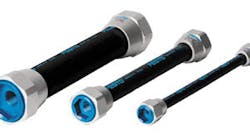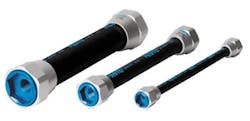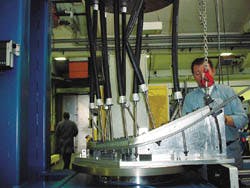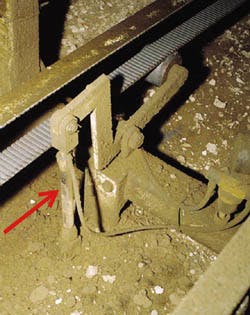Almost everyone has observed that when flexible hoses are pressurized, they expand in the radial direction and contract in the axial direction. Festo Corp. exploits this phenomenon in a new type of actuator they call the Fluidic Muscle.
Comparing the force curves of the two types of actuators reveals another important difference. A cylinder delivers force over its entire stroke, while the Fluidic Muscle develops its full force only when initially stretched. This force decreases as a linear function of distance, petering out at around 20 to 25% of the Muscle's total length. Remember that the Muscle develops its maximum force directly from a neutral position. This makes the Muscle very suitable for highly dynamic applications, particularly if the stroke is short.
* are totally free of friction between any surfaces, and thus unaffected by the stiction which may cause problems in many cylinders. They deliver power smoothly.
* have one major limitation when compared to cylinders. They cannot guide nor push. They can only pull.
* contract as a direct function of pressure by a precisely predictable amount. As a result, they can be used to create simple positioning systems in which pressure is regulated in proportion to the desired end position, with highly repetitive, almost servo-like accuracy.
* have difficulty dealing with static loads over a long period of time (500 hours or more), because the materials relax.
* can cope with temperatures as high as 60° C. If this temperature is exceeded for long periods, the Muscle doesn't immediately fail, but its service life is reduced.
* cannot dissipate internal heat very quickly through the rubber tube. Therefore, Festo advises that the supply and exhaust ports be located at opposite ends, so fresh cool compressed air flows through during each cycle.
* are exceptionally easy to service. The tubing is available by the meter and can be cut to length with a knife easily and quickly. The metal clamping caps bolt in place.
Note that differences between the geometries of Fluidic Muscles and cylinders can be decisive. In the case where each device can develop the same force, the Muscle will be roughly twice as long as the cylinder (but considerably slimmer). Thus, the choice between the two devices might depend on the space available. In general, due to this size difference, it is very unlikely that a Fluidic Muscle could directly replace a pneumatic cylinder.
Telephone Festo Corp., Hauppauge, N.Y., at 800 / 993-3786 or fax them at 800 / 963-3786.




